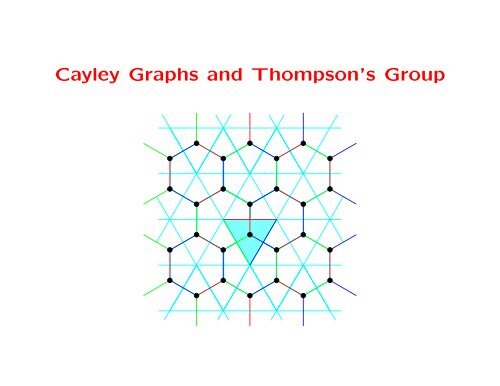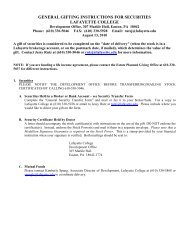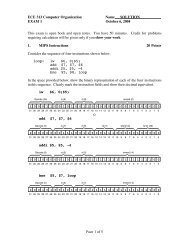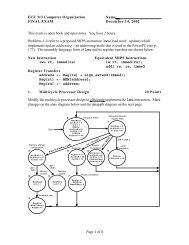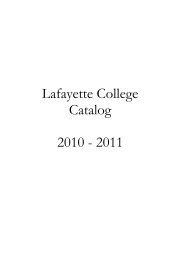Cayley Graphs and Thompson's Group
Cayley Graphs and Thompson's Group
Cayley Graphs and Thompson's Group
Create successful ePaper yourself
Turn your PDF publications into a flip-book with our unique Google optimized e-Paper software.
<strong>Cayley</strong> <strong>Graphs</strong> <strong>and</strong> Thompson’s <strong>Group</strong>
<strong>Cayley</strong> <strong>Graphs</strong><br />
<strong>Cayley</strong> graphs are geometric objects used to study finitely generated<br />
groups. Let G be a group <strong>and</strong> let S be a finite generating set<br />
for G. Then the associated <strong>Cayley</strong> graph Γ have vertices associated<br />
to the elements of G <strong>and</strong> (directed) edges corresponding<br />
to right multiplication by the elements of S.<br />
(12)<br />
(12)<br />
e<br />
e<br />
(132)<br />
(123)<br />
(132)<br />
(123)<br />
(23) (13)<br />
(23) (13)<br />
2
Dihedral <strong>Group</strong>s<br />
Dihedral groups are generated by a reflection <strong>and</strong> a (minimal,<br />
non-trivial) rotation. The associated <strong>Cayley</strong> graph for D 4 is:<br />
This highlights that <strong>Cayley</strong> graphs often illuminate the geometry<br />
underpinning a group.<br />
3
Alternating <strong>Group</strong>s<br />
The alternating groups are key examples of finite simple groups.<br />
One of this weekend’s speakers, Martin Kassabov, has created<br />
a family of exp<strong>and</strong>er graphs using <strong>Cayley</strong> graphs of Alternating<br />
groups. Below is the <strong>Cayley</strong> graph of A 4 using (123) <strong>and</strong><br />
(12)(34) as generators. (The picture is stolen from Wolfram’s<br />
Mathworld.)<br />
4
Infinite <strong>Group</strong>s<br />
While the main questions about <strong>Cayley</strong> graphs of finite groups<br />
are combinatorial, the main questions about <strong>Cayley</strong> graphs of<br />
infinite groups are geometric.<br />
5
Another Infinite <strong>Group</strong><br />
Here’s the <strong>Cayley</strong> graph of a reflection group:<br />
6
Geometric Questions<br />
Many questions are framed in terms of “balls” <strong>and</strong> “spheres” in<br />
the <strong>Cayley</strong> graph.<br />
7
Geometric Questions<br />
1) Growth?<br />
2) “Convexity”?<br />
8
Thompson’s <strong>Group</strong><br />
Thompson’s group F consists of certain piecewise linear functions<br />
from the closed interval [0, 1] to [0, 1]:<br />
9
Generators?<br />
Every element of F can be expressed as a product of the following<br />
two elements <strong>and</strong> their inverses:<br />
10
Strange Facts ...<br />
So F ⊕ F < F !<br />
Sean Cleary (<strong>and</strong> others): The <strong>Cayley</strong> graph of Thompson’s group<br />
1) has “pockets”<br />
2) has no “convexity”<br />
11


